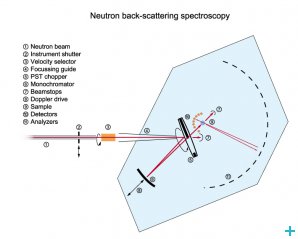Back-scattering spectrometry
The technique and the facilities where you can find them
Overview
Neutron backscattering experiments are performed to study atomic or molecular motion on a nanosecond time scale. This method improves the energy resolution of neutron spectrometers by about two orders of magnitude, pushing it into the µeV range.
In physics, back-scatter (or back-scattering) is the reflection of waves, particles, or signals back to the direction they came from.
The main idea of backscattering consists in using a Bragg angle close to 90° for the selection and for the analysis of the wavelength λ of neutrons or X rays in a spectrometer or diffractometer. Under this condition the Bragg reflected wavelength band Δλ becomes very narrow. This can be seen easily by differentiating the Bragg equation.
Lay out of a back-scattering spectrometer
In a back-scattering spectrometer, both monochromator and analyser are operated under backscattering conditions, which allows to obtain energy resolutions between 10-3 and 10-4eV.
Beside the three axes (monochromator (6), sample (9), analyser (11)) there are two more elements in the beam path. They are required to cope with the very special 2ϴ = 180° geometry. Obviously the sample cannot be placed in the incoming beam. Therefore a deflector is needed to redirect the back-scattered beam into the secondary spectrometer which is placed in a separate housing outside the primary beam casemate.
Neutrons that are back-scattered from an analyser have to traverse the sample a second time before they reach the detector. This geometry exposes the detector to neutrons that are scattered directly from the sample into the detector, without being energy analysed. These uninformative neutrons have to be discounted. Therefore, every back-scattering instrument needs a chopper to pulse the incoming beam. Analysed and unanalysed neutrons are then distinguished by their different time of flight.
In back-scattering spectroscopy it is not possible to vary the Bragg reflection angles in the monochromator and /or analyser to select energies, as even a few degrees deviation from 2ϴ = 180° would ruin the energy resolution. Instead, two other methods are used to vary hω = Ei – Ef : a) Varying the lattice constant of the monochromator by cooling /heating b) Doppler shift of Ei by periodic motion of the monochromator.
Keeping the Bragg angles fixed facilitates simultaneous measurements at different scattering angles: back-scattering spectrometers are always built as multi-detector instruments.
Where to find this technique?
Back-scattering spectrometry can be found at:

